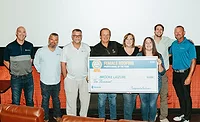RC Contractor Q&A: Sam Stilley
Leveraging Technology Became a Point of Emphasis for Amstill Roofing at Just the Right Time
.webp?t=1641310260)
Sam Stilley speaking at the 2019 Best of Success conference.
For some roofing contractors, the COVID-19 pandemic and economic uncertainty that followed created an opportunity. Those like Sam Stilley, who worked through the pause in production forced by health and safety concerns, also had a chance to reflect on what systems and processes worked best and what would be needed to spur future success.
The CEO of Houston, Texas-based Amstill Roofing has always pushed the importance of incorporating new technology to improve operations and the overall customer experience. He discovered a few tools that not only helped him excel in a digital sales environment, but also navigate lingering supply issues and enhanced customer expectations.
He recently answered the following in a video chat with RC that we’re sharing here:
RC: What’s the state of roofing in a major market like Houston?
SS: Despite the material shortages, purchasing seems to be at an all-time high, which is quite stressful I'm sure, for our distribution friends. But everyone seems to be steady on purchasing. The housing market is still strong in the Houston area … and with that it seems like there's more roofing companies popping up than ever, because I think people are trying to get into a “recession-proof” industry, and roofing is quite that, in my opinion.
RC: How have you navigated those supply issues to meet customer expectations?
SS: I think the running joke has been “Do you want gray, black or brown?” and that was really evident in the first half of the year color-wise. If anyone wanted a color other than that we told them it's going to be eight to 10 weeks.
We've been very blessed with our relationship with Beacon here in Houston. The supply shortages haven’t affected us tremendously unless it's a specialty color or a specialty product. And now, in this case, we're not even offering specialty products.
RC: What have you learned about supply chain during this crisis, and what new tech tools have you found useful?
SS: From a systems of purchasing we really leveraged our AccuLynx CRM by allowing us to have a backlog of jobs that were sold of colors that were selected, as well as with our HOVER data that we have. Essentially, when a job was sold, it allowed us to have predetermined colors as well as the quantities. Since we weren't building it tomorrow — we consistently have a two-week backlog — it immediately takes those batches of orders or sales of that day or of those running three or four days, and we would actually send it to our distributor ahead of time.
 Sam Stilley with his father, Amstill Roofing founder Frank Stilley.
Sam Stilley with his father, Amstill Roofing founder Frank Stilley.RC: Why is that particularly powerful?
SS: Technically we’re not placing the order four weeks in advance, but we're giving them a notice. Then we will place the order with them about two weeks prior, so they’re allowed to do their back-end logistics to make sure those products are available for us based off us giving them a head’s up.
RC: Despite that success with technology, do you believe roofing will always be a kitchen-table sales process, or have we ventured into a new era?
SS: I think that that's on everyone's mind right now, and I think that those that are really concerned about that are the ones that haven't adapted to any type of technological change to their company. I don't think door knocking will ever truly leave our space … and I think that kitchen-table experience will slowly shift to more digital transactions.
RC: Is that good for the roofing customer?
SS: Am I a fan of digital transactions? Not necessarily. But guess who is? My clients, and I have to change my business model to fit my client's needs, otherwise my client's needs will be fulfilled by another company. I'm losing out or not going to have an opportunity because I'm not willing to change the business to make it more appealing to consumers. I think that mindset is what allows other companies to flourish.
RC: Not everyone has the capital to invest in new technology, or do they?
SS: I want to let you know that if you don't have the capital, I was once in your shoes. When I got involved in the business, we had roughly $800 in an account for marketing. We grew, to the point to where we spend up to $70,000 a month, depending on what we're targeting. But that was all grassroots. No outside investments, no loans, and it was solely based off of the determination of two years of hard work in taking the sales and the net profitability of a sale and putting it back into the business.
RC: Your father, company founder Frank Stilley, has embraced new technology to enhance Amstill’s decades of experience in sales and service. Not everyone is so fortunate. What’s your message to other young contractors?
SS: So if you truly want to have something in life, the best person who is going to make it happen is yourself. And I want to encourage everyone who's listening to understand that the only thing that will stop you from achieving that is you.
RC: How do they get the message across that change is critical in today’s market?
SS: Ultimately, it’s going to come down to a trust factor. You’ve got to understand and realize that older generation business owners have been successful for a certain amount of time. Don’t come into a meeting with an executive or whoever’s been around for a long time without facts and data to support your decisions. If it makes sense, on paper, and it can be proven, I mean this is all just math!
RC: What are you excited about for 2022?
SS: I’m very excited about moving into our new facility. It’s about 5,000 square feet and two stories, and we're really, really excited about having the space, not only for growth but for collaboration. I think people on an individual level, when they have more space, they have more free thinking. They don't feel as confined as they do in a small office or with multiple other people in an office. They can share their ideas and thoughts that can allow us as a company to become better for our community.
RC: What has you optimistic about the roofing industry entering 2022?
SS: I am optimistic about the industry. We're seeing a huge change in the past five years of people being forced to either get in the tech space for roofing or potentially face having their doors closed or business slowly decline. I think in the next five years we're going to see an enormous amount of change of other tech companies competing in this space.
Ultimately, they're going to be competing for us — for who can have the best product or the best service with that product. And I think that type of competition in our space is going to allow us to have an even better system that can help us at the kitchen table or with safety or whatever it may be. The roofing space is always lagging behind when it comes to adoption and I feel like now it's kind of finally getting the attention it deserves.
Looking for a reprint of this article?
From high-res PDFs to custom plaques, order your copy today!







